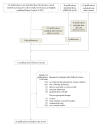Subsite-specific dietary risk factors for colorectal cancer: a review of cohort studies
- PMID: 23577027
- PMCID: PMC3610350
- DOI: 10.1155/2013/703854
Subsite-specific dietary risk factors for colorectal cancer: a review of cohort studies
Abstract
Objective. A shift in the total incidence from left- to right-sided colon cancer has been reported and raises the question as to whether lifestyle risk factors are responsible for the changing subsite distribution of colon cancer. The present study provides a review of the subsite-specific risk estimates for the dietary components presently regarded as convincing or probable risk factors for colorectal cancer: red meat, processed meat, fiber, garlic, milk, calcium, and alcohol. Methods. Studies were identified by searching PubMed through October 8, 2012 and by reviewing reference lists. Thirty-two prospective cohort studies are included, and the estimates are compared by sex for each risk factor. Results. For alcohol, there seems to be a stronger association with rectal cancer than with colon cancer, and for meat a somewhat stronger association with distal colon and rectal cancer, relative to proximal colon cancer. For fiber, milk, and calcium, there were only minor differences in relative risk across subsites. No statement could be given regarding garlic. Overall, many of the subsite-specific risk estimates were nonsignificant, irrespective of exposure. Conclusion. For some dietary components the associations with risk of cancer of the rectum and distal colon appear stronger than for proximal colon, but not for all.
Figures








Similar articles
-
Red meat consumption and risk of cancers of the proximal colon, distal colon and rectum: the Swedish Mammography Cohort.Int J Cancer. 2005 Feb 20;113(5):829-34. doi: 10.1002/ijc.20658. Int J Cancer. 2005. PMID: 15499619
-
Meat intake, cooking methods and risk of proximal colon, distal colon and rectal cancer: the Norwegian Women and Cancer (NOWAC) cohort study.Int J Cancer. 2013 Sep 1;133(5):1153-63. doi: 10.1002/ijc.28101. Epub 2013 Mar 29. Int J Cancer. 2013. PMID: 23401013
-
A Comprehensive Model of Colorectal Cancer by Risk Factor Status and Subsite Using Data From the Nurses' Health Study.Am J Epidemiol. 2017 Feb 1;185(3):224-237. doi: 10.1093/aje/kww183. Am J Epidemiol. 2017. PMID: 28073766 Free PMC article.
-
Dietary Patterns and Risk of Colorectal Cancer: Analysis by Tumor Location and Molecular Subtypes.Gastroenterology. 2017 Jun;152(8):1944-1953.e1. doi: 10.1053/j.gastro.2017.02.015. Epub 2017 Feb 27. Gastroenterology. 2017. PMID: 28249812 Free PMC article.
-
Consumption of red meat and processed meat and cancer incidence: a systematic review and meta-analysis of prospective studies.Eur J Epidemiol. 2021 Sep;36(9):937-951. doi: 10.1007/s10654-021-00741-9. Epub 2021 Aug 29. Eur J Epidemiol. 2021. PMID: 34455534
Cited by
-
Sex- and gender-specific disparities in colorectal cancer risk.World J Gastroenterol. 2015 May 7;21(17):5167-75. doi: 10.3748/wjg.v21.i17.5167. World J Gastroenterol. 2015. PMID: 25954090 Free PMC article. Review.
-
Blood Bacterial DNA Load and Profiling Differ in Colorectal Cancer Patients Compared to Tumor-Free Controls.Cancers (Basel). 2021 Dec 18;13(24):6363. doi: 10.3390/cancers13246363. Cancers (Basel). 2021. PMID: 34944982 Free PMC article.
-
Common dietary patterns and risk of cancers of the colon and rectum: Analysis from the United Kingdom Women's Cohort Study (UKWCS).Int J Cancer. 2018 Aug 15;143(4):773-781. doi: 10.1002/ijc.31362. Epub 2018 Apr 1. Int J Cancer. 2018. PMID: 29516512 Free PMC article.
-
CD14 and IL18 gene polymorphisms associated with colorectal cancer subsite risks among atomic bomb survivors.Hum Genome Var. 2015 Oct 8;2:15035. doi: 10.1038/hgv.2015.35. eCollection 2015. Hum Genome Var. 2015. PMID: 27081544 Free PMC article.
-
Tea, coffee, and milk consumption and colorectal cancer risk.J Epidemiol. 2014;24(2):146-53. doi: 10.2188/jea.je20130063. Epub 2014 Feb 15. J Epidemiol. 2014. PMID: 24531002 Free PMC article.
References
-
- Ferlay J, Shin HR, Bray F, Forman D, Mathers C, Parkin DM. GLOBOCAN 2008: Cancer Incidence and Mortality Worldwide. Lyon, France: International Agency for Research on Cancer; 2012. (IARC Cancer Base, no. 10).
-
- Slater GI, Haber RH, Aufses AH., Jr. Changing distribution of carcinoma of the colon and rectum. Surgery, Gynecology & Obstetrics. 1984;158:216–218. - PubMed
-
- Toyoda Y, Nakayama T, Ito Y, Ioka A, Tsukuma H. Trends in colorectal cancer incidence by subsite in Osaka, Japan. Japanese Journal of Clinical Oncology. 2009;39(3):189–191. - PubMed
-
- Cucino C, Buchner AM, Sonnenberg A. Continued rightward shift of colorectal cancer. Diseases of the Colon and Rectum. 2002;45(8):1035–1040. - PubMed
LinkOut - more resources
Full Text Sources
Other Literature Sources

